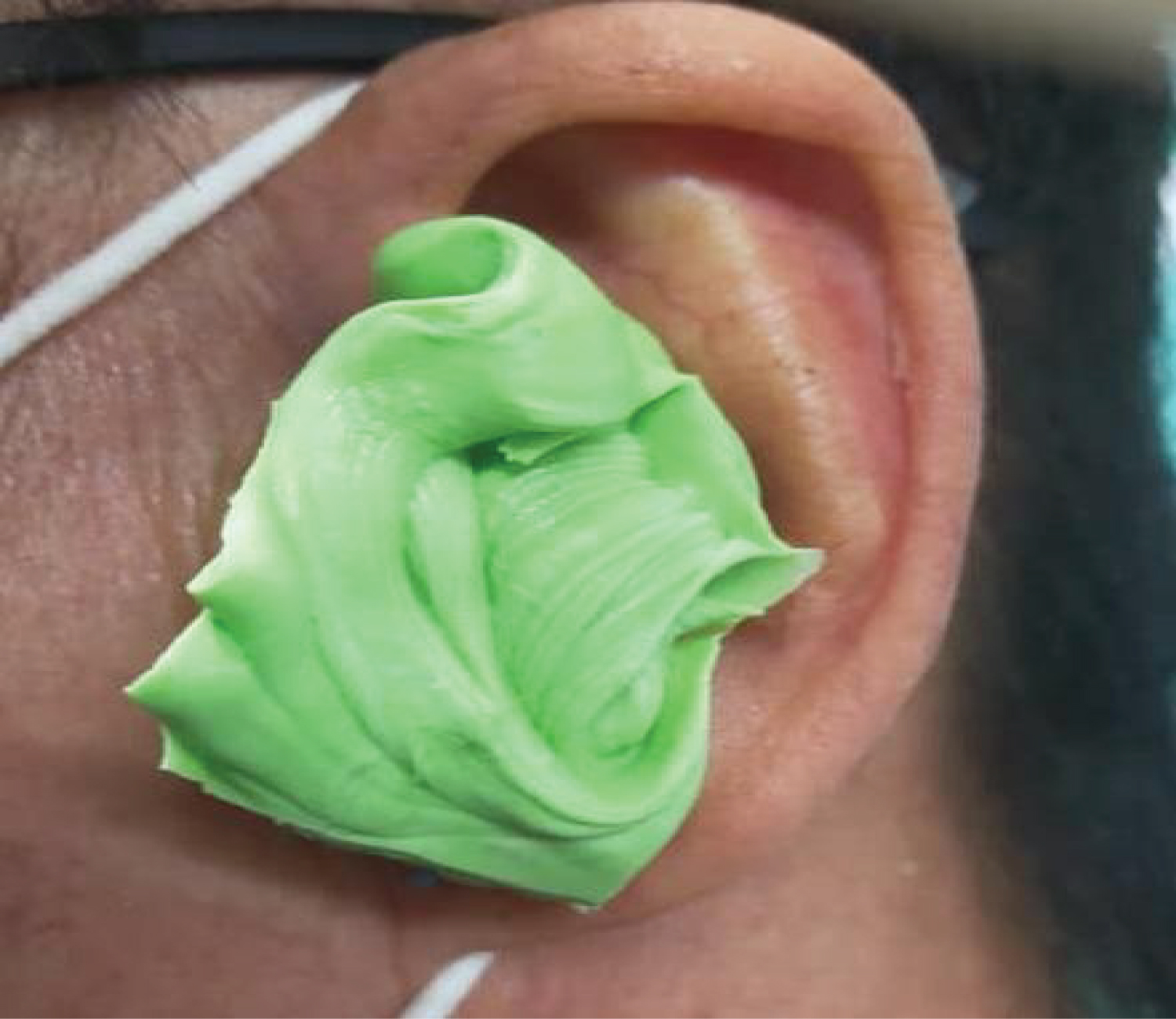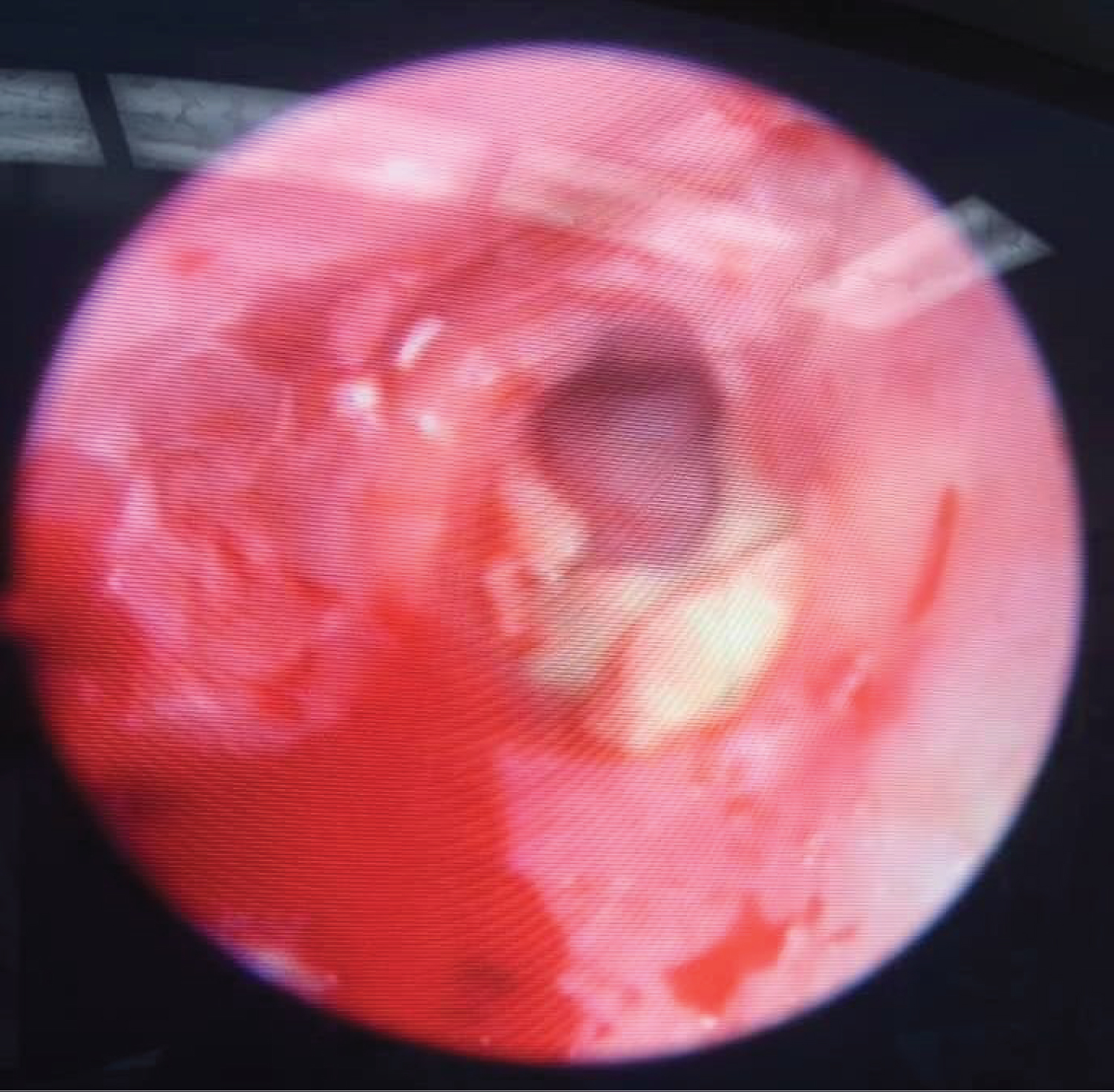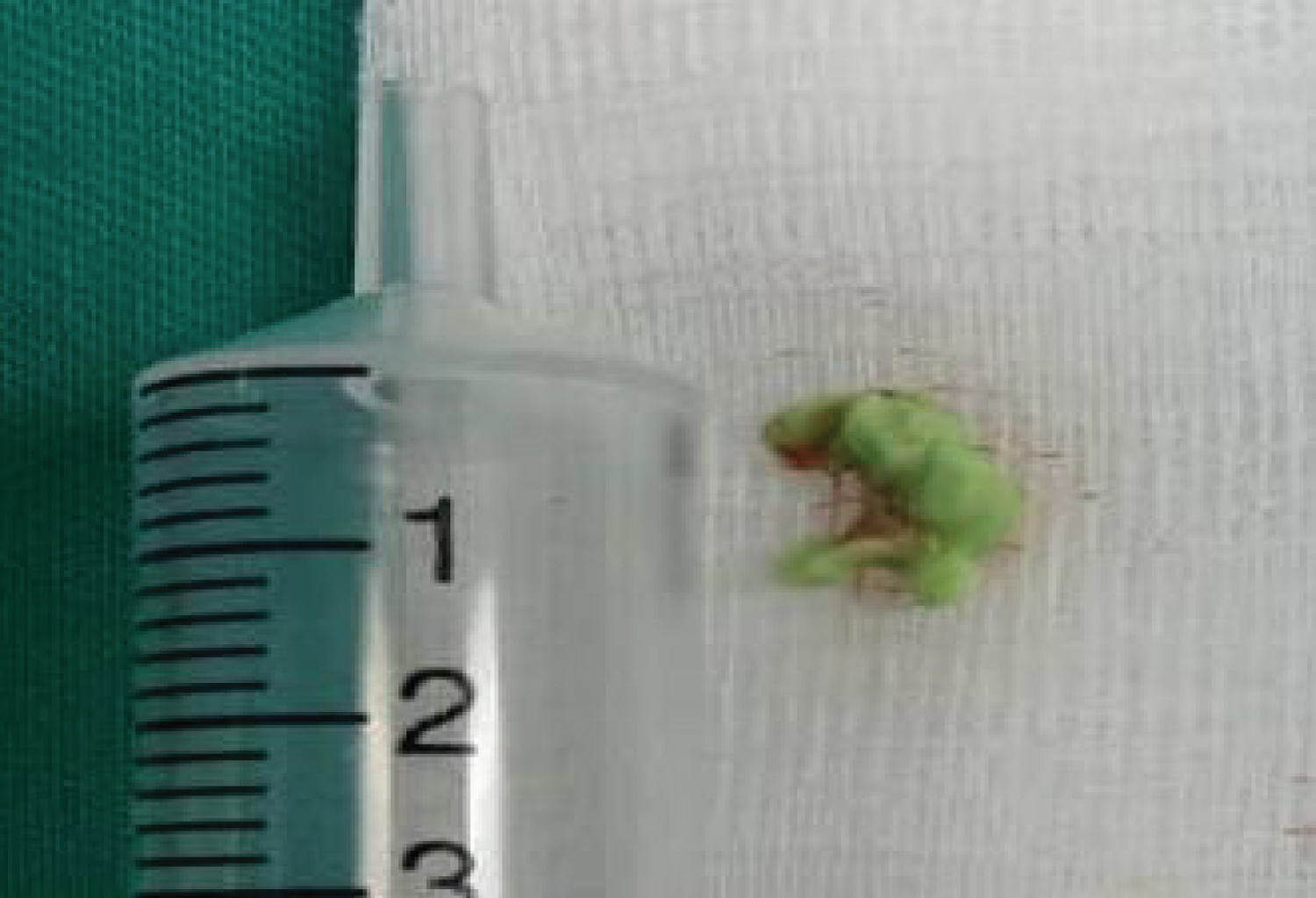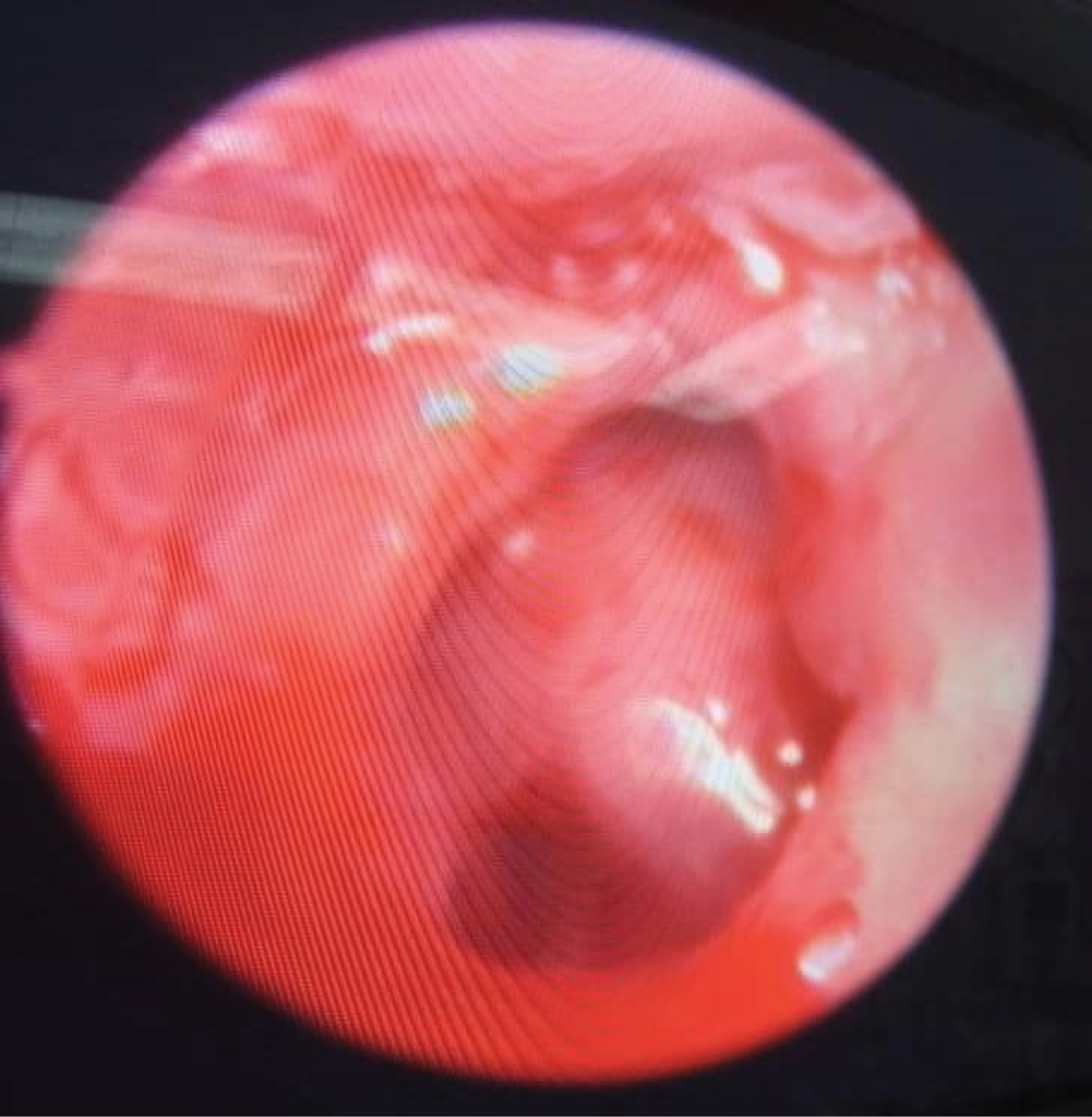Hearing aid is an electronic device fitted to the ear and designed to amplify and deliver sound to the ear. Upon fitting a hearing aid, patients are required to make an earmold impression material for device fixation based on patient's personal preference, the shape and texture of the ear. Complications while making an earmold for hearing aids are rare but during this process, the impression material can be accidentally entered in the middle ear through a perforation on the tympanic membrane. Here we report a case of 60 years old Chinese gentleman with a foreign body in the middle ear during earmold impression procedure in a private hearing aid centre. Removal of earmold impression material in middle ear was performed under general anesthesia without serious complications.
Earmold impression, Foreign body, Middle ear, Hearing aid
An earmold is a device worn inserted into the ear for sound conduction or hearing protection. The parts of hearing aid that fit inside the ear come in two basics styles: earmold or dome style. Earmolds are made of either plastic or silicone and custom-fit so that they sit snugly and precisely within the ear canal. They have small vents in them to let air through. Depending on the type and degree of hearing loss, and the anatomy of the ear, the earmold can be canal size (small), half-shell size (medium) or full-shell size (large). The kind of earmold that patients wear is depends on patient's personal preference, the shape and texture of the ear and also patient's specific hearing aid. Since ears come in all shapes and sizes, it's important to have a hearing healthcare professional customize an earmold to fit the shape of patient's ear. These devices, must be tight enough to prevent sound from leaking out and creating feedback but not so tight as it may cause ear pain [1].
When fitting hearing aids, patients are required to make an earmold impression material for device fixation. It usually causes no problems, although in rare cases, the earmold impression material can passes through the middle ear through tympanic membrane perforations. This condition is called as earmold impression material foreign body in the middle ear and required surgical removal of foreign body which if not immediately removed it may cause an inflammatory reaction and deterioration of aeration, especially in the Eustachian tube [2].
A 60 years-old Chinese gentleman was referred to Otorhinolaryngology (ORL) clinic of Hospital Pakar Sultanah Fatimah for suspicion of a foreign body in the middle ear. The patient had underlying dyslipidemia and history of bilateral inactive chronic otitis media with a long-standing hearing disturbance which is bilateral profound mixed hearing loss. In view of patient had hearing loss and difficulty in communications, a behind the ear (BTE) type of hearing aid was prescribed, and an impression molding procedure was performed at a private hearing aid centre in Muar, Johor using silicone type material. During the procedure, patient complained of ear pain since the silicone molding material entered his left ear canal. The audiologist subsequently tried to remove the silicone earmold but unsuccessful as it was stucked in the left ear canal. Hence, the patient was immediately referred to our clinic for removal of the earmold impression.
On arrival patient complained of slight pain and discomfort in the left external auditory canal. On inspection a green color silicone impression material was seen in the left pinna and external auditory canal (EAC). Otoscopic examination over right ear shows normal findings however unable to examine left ear due to restriction by the earmold foreign body. Attempted removal of the impression material in the ORL clinic, however we only managed to remove the earmold over the left pinna and left external auditory canal in pieces. On endoscopic examination revealed a subtotal left tympanic membrane perforation with erythema and laceration of the canal wall and also a visible greenish foreign body in the floor of the left middle ear. This case was then posted to operation theatre for examination under microscope and removal of the middle ear foreign body under general anesthesia. Intraoperatively, there were laceration wound over posterior and floor of ear canal wall, a subtotal perforation at pars flacida of tympanic membrane with a green color of silicone material earmold seen adhered at the floor of left middle ear cavity. Surgical removal of foreign body was done successfully with minimal bleeding, middle ear mucosa appears healthy with no pus discharge or granulation tissue. The surgery was performed without any other complications. Post operatively, patient was well and uneventful with no active complaints and he was discharged home the next day with oral and topical antibiotics.
 Figure 1: Silicone material earmold impression stucked inside patient's left ear canal.
View Figure 1
Figure 1: Silicone material earmold impression stucked inside patient's left ear canal.
View Figure 1
 Figure 2: Endoscopic examination shows greenish foreign body in the floor of middle ear.
View Figure 2
Figure 2: Endoscopic examination shows greenish foreign body in the floor of middle ear.
View Figure 2
 Figure 3: The silicone impression material was totally removed en bloc.
View Figure 3
Figure 3: The silicone impression material was totally removed en bloc.
View Figure 3
 Figure 4: Endoscopic view of left middle ear cavity post removal of the foreign body.
View Figure 4
Figure 4: Endoscopic view of left middle ear cavity post removal of the foreign body.
View Figure 4
Hearing is one of the most precious senses that we have. Through hearing we are able to develop our language and communication skills, to hear the disturbing sounds of machines, to enjoy wonderful sounds of music and are made aware of incoming harms. Most of us are extremely blessed to be born with perfectly normal hearing. However there are a few unfortunate ones who were born without this ability. There are also people who gradually lose their hearing abilities due to various reasons such as the aging process, infections, tumours, trauma, exposure to ototoxic drugs and also exposure to work / environment related hazards.
With the advancement of technology the disability resulting from hearing loss could be reduced. The hearing aid is actually a wonderful electronic device fitted to the ear and designed to amplify and changes sounds for improved hearing. Audiologists are the professionals singularly qualified to prescribe and fit all forms of amplification for hearing- impaired persons. The patients needs would differ individually. Improper assessment, prescription and fitting of hearing aids will lead to certain problems, resulting in failure of using hearing aids.
Before using a hearing aid, patients usually required to do a hearing aid fitting session which earmold Impression will be performed depends on patient's personal preference, the shape and texture of the ear. Producing a hearing aid mold is not difficult for experienced personnel. However, molding materials may trigger serious complications such as infection in the middle ear, dizziness, perilymphatic fistula, facial nerve injury due to the foreign body could occur if there is any history chronic otitis media. During removal of foreign body in middle ear surgery adequate visualization and careful removal are mandatory to avoid further injury in the ear canal as well in the middle ear structures to avoid any serious complications post operation [3,4].
In this case, we report an immediate complication during hearing aid earmold impression procedure which is earmold impression material foreign body in the middle ear. It is essential that the audiologist perform a basic otological examination before prescribing a hearing aid and preparing an ear mould. Besides, hearing aid- dispensing audiologists should be well trained in appropriate educational programs with possible external or middle ear problems by otology specialists. In addition, hearing aid impression material-related complications should be referred immediately to an otology specialist to prevent any further serious complications that could be irreversible. Care should be taken to put adequate cotton plug in the external canal prior to the procedure as elastic nature of silicone impression material makes it difficult to be removed.
Kim, et al. [1] reported a similar case of a 77-year-old woman but in his case an intact canal wall mastoidectomy with facial recess approach was performed to remove the foreign body. Hyun-min, et al. [5] reported a case of hearing aid silicone impression material as a foreign body in the middle ear in 2017 and an intact canal wall mastoidectomy with a facial recess approach and type IV tympanoplasty was performed to remove the silicone impression material. Shasinder, et al. [4] also reported similar case in a 12-year old boy and the impression material was removed permeatally. Meanwhile, this is the first case that we have encountered in our center.
In summary, the earmold should be made by an experienced person trained in this field. Prevention should be the mainstay of treatment. A cotton, an ear plug or some other protective devices should be inserted prior to the mould impression making. Proper protocol should be strictly followed during the process of making ear mould impression as the silicone is a recommended and safe material to make the impression. We presumed there was no protective device being used in this patient while making the mould impression. In addition, a case of impacted earmold impression material should be removed by an experienced Otorhinolaryngologist to prevent further damage in the middle ear structure [6].
Impression material foreign bodies of the middle ear are rarely reported. Careful removal under general anaesthesia should be done by an experienced Otorhinolaryngologist. This is to ensure that the middle ear structures are not disturbed or damaged. In addition, it is essential that the audiologist perform a basic otological examination for extra precautions before preparing an earmold and the earmold should be made by an experienced person trained in this field.